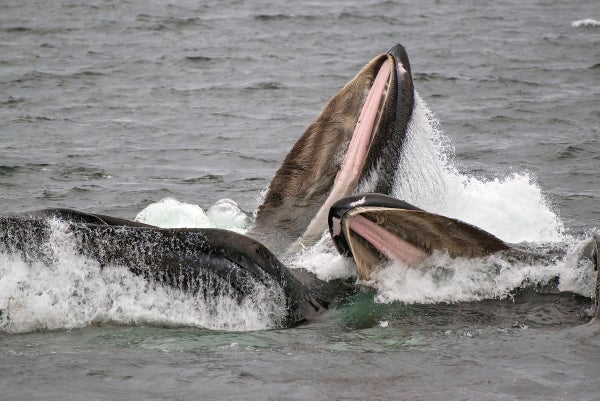When most large whales—such as blue, minke and humpback whales—chow down, they don’t chew their food with teeth. Instead they employ hundreds of baleen plates that hang from their upper jaw like prickly curtains to filter minuscule prey from the ocean. First the whales gulp vast amounts of seawater into their massive maw. Then, like an enormous juice press, they close their jaws and squeeze the water out through the baleen. As the water escapes, krill and small fish are snagged by the baleen’s bristles. Some whales use this method to devour up to around 20 tons of seafood each day.
Baleen also bristles with useful environmental data, according to a new study that demonstrates how its chemical makeup can help scientists reconstruct details ranging from whales’ migration routes to their diets. Researchers have generally used satellite tags to track whales—but the tags are difficult to deploy and often suddenly stop transmitting. And fastening them to slick hides requires massive pins that may harm the animals. “Baleen is a better record for looking at the life history because it’s a solid part that’s preserved for a relatively lengthy time,” says study co-author Philip Riekenberg, a biogeochemist at the Royal Netherlands Institute for Sea Research.
Baleen, which looks like a coarse, worn scrub brush, is made of keratin—the same material as human fingernails. Keratin is durable and flexible, which made baleen a popular by-product of 19th-century whaling. As whales were hunted for their oil, people fashioned baleen into products such as hairbrushes and corsets.
On supporting science journalism
If you're enjoying this article, consider supporting our award-winning journalism by subscribing. By purchasing a subscription you are helping to ensure the future of impactful stories about the discoveries and ideas shaping our world today.
The proteins, hormones and elements such as carbon and nitrogen from whales’ diets are incorporated into the successive layers of keratin that grow from their gums. “As the baleen grows out like fingernails, it integrates the signal of what they’re actually eating,” Riekenberg says. This process continues throughout a whale’s lifetime. A mature bowhead whale, for example, can sport baleen that stretches out to be more than 14 feet long.
.jpg?w=900)
Baleen samples to be studied for chemical clues to the diet of the whale they came from. Credit: Philip Riekenberg
Other sources, including plugs of whale earwax (which record environmental conditions, such as pollutants, like rings of a tree stump), provide lengthy records from the course of a whale’s lifetime. But long strands of baleen offer an unparalleled glimpse into what these animals are eating—which often informs where they have been. To gauge how thorough this baleen record is, Riekenberg and a team of scientists in the Netherlands recently examined baleen from five whales: three juvenile fin whales, one adult humpback whale and a minke whale of undetermined age.
Unlike skin samples, baleen must be collected postmortem. “You cannot go out and take the baleen off of a living animal,” Riekenberg says. Instead the team took baleen plates from whale specimens that had either stranded on Dutch beaches or been fatally struck by unsuspecting boats.
Back at the lab, the baleen plates were frozen, cleaned and measured. Then the scientists drilled holes into the material at regular intervals to harvest keratin powder, which they ran through a battery of chemical tests. Their findings, published this week in Royal Society Open Science, show baleen’s potential as an environmental time capsule. For example, levels of the isotope nitrogen 15—a useful barometer for determining what is on a particular whale’s menu—waxed and waned throughout each sample. This seemed to correlate with each whale’s migration pattern. During the summer, these whales gorge themselves in rich arctic waters, spiking the nitrogen 15 levels in their baleen. In the winter, they fast as they travel south to breed in the mid-Atlantic, causing their nitrogen 15 levels to plummet.
But there is a limit to what nitrogen isotopes can tell researchers. A similar fluctuation could be caused by a dietary shift from mainly eating krill to devouring entire schools of herring. “You see a difference, but you can’t identify whether it’s a difference in what they’re feeding on or if it’s a change in their baseline environment,” Riekenberg says.
To address that quandary, the team looked at the baleen samples’ makeup of protein-building amino acids, which correlate to specific background environmental conditions or prey. They found the dietary preference of each species remained stable throughout each baleen sample, making it likely that nitrogen fluctuations resulted from the animals’ annual voyages throughout the Atlantic Ocean.
Pinpointing when and where particular whales move is vital, according to Nadine Lysiak, a marine ecologist at Boston’s Suffolk University, who was not involved in the study. She has used similar baleen isotope techniques to track endangered North Atlantic right whales, which are often struck by boats or ensnared in fishing lines. “We have a good understanding of their generalized migration behavior, but there are still major holes in our knowledge of where these whales go across a year,” Lysiak says. “Stable isotopes are natural markers, and when measured in something like baleen, they [provide] a continuous record of an animal’s movements.”
Riekenberg says baleen could help researchers address a range of questions about how these giants are responding to warming ocean temperatures, which threaten to throw marine food webs and migration patterns into disarray. This is why he thinks studying beached whales and those hit by ships is an important way to monitor how their metabolism may be responding to the shifting environment. “These are opportunistic samplings that you hate to see,” he says. “But we’re using the collection of archived animals to address what happens to these animals before they strand.”
